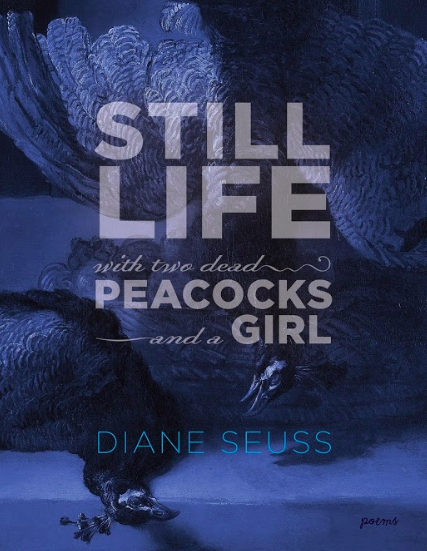In this 31 Books in 30 Days series series leading up to the March 14, 2019 announcement of the 2018 National Book Critics Circle award winners, NBCC board members review the thirty-one finalists. Today, NBCC board member Victoria Chang offers her appreciation of poetry finalist Diane Seuss’s Still Life with Two Dead Peacocks (Graywolf Press).

While I am an avid fan and user of social media and love how it’s opened up the literary world, particularly the poetry world, in all sorts of ways, one of my secret fears is that poets will begin to sound like other poets because we now have access to poems and poetry at a more rapid speed as poems get shared and can go rapidly viral.
Diane Seuss’s fourth book of poems, Still Life with Two Dead Peacocks and a Girl, completely allays my fears because it’s utterly original. Seuss’s book uses Rembrandt’s seventeenth-century painting, other paintings, and the ekphrastic as a way to refract and ruminate on the speaker’s life in interesting ways. In essence, the paintings and the ekphrastic serve as a frame that enables Seuss to complicate her poems in ways that simple autobiographical poems cannot.
Seuss also innovates the ekphrastic. Instead of taking on a whole painting at one time (more typical of ekphrastic poems), she breaks Rembrandt’s painting into 13 sections or fragments—for example, the folded hands of the girl in the painting, a feather, a bowl of fruit, a dead peacock’s face with its open eyes. Some poems within each section riff off of these art fragments.
Not until the final section do we see Rembrandt’s full painting of the girl gazing longingly at two dead and contorted peacocks, one hanging upside down from a wall and another on its side, nearly upside down with blood pooling from its body. Isn’t this what happens in real life—we have much more clarity in hindsight, sometimes, years or decades after something has happened? And only after little shards of memory infiltrate our consciousness, followed sometimes by fragmentary reflection? In these ways, Seuss’s art mirrors understanding or at least our attempts at understanding our very fragmented and mysterious lives. In breaking art into pieces, it’s as if Seuss is saying life is process versus product. Only in breaking apart life can we even begin to understand it. And perhaps the pieces are more important than the who
Moreover, Seuss uses painting, often associated with high art, to investigate issues of gender, class, and America. There’s Rembrandt, Pollock, O’Keefe, and Rothko, juxtaposed to Walmart, stacks of bills, phone cords, cig butts, potpies, pickled peppers, pork rinds, and freezer-burned Dreamsicles.
Seuss’s book is a wonderfully sophisticated and mature collection. You get the sense that there’s a life lived underneath these poems. Thankfully Seuss also has the poetic skills to reflect and articulate about a deeply lived life in new and interesting ways through riffing language, frequent collisions of disparate subject matter, and linguistic bravado. That combination of maturity with poetic skill is what makes Still Life with Two Dead Peacocks and a Girl sparkle and makes me look forward to all of Diane Seuss’s future books.
Victoria Chang’s fourth book of poems, Barbie Chang, was published by Copper Canyon Press in 2017. The Boss (McSweeney’s) won The PEN Center USA Literary Award and a California Book Award. Other books are Salvinia Molesta and Circle. She was awarded a Guggenheim Fellowship and a Sustainable Arts Foundation Fellowship in 2017, along with the Poetry Society of America’s Alice Fay Di Castagnola Award. She is a contributing editor of Copper Nickel and a poetry editor at Tupelo Quarterly. She teaches at Antioch University’s MFA program in Los Angeles. You can find her at http://www.victoriachangpoet.com

